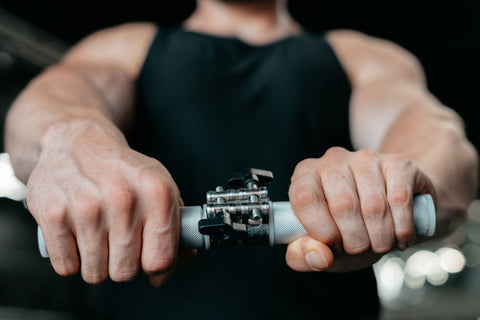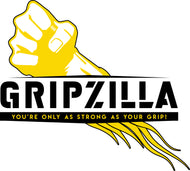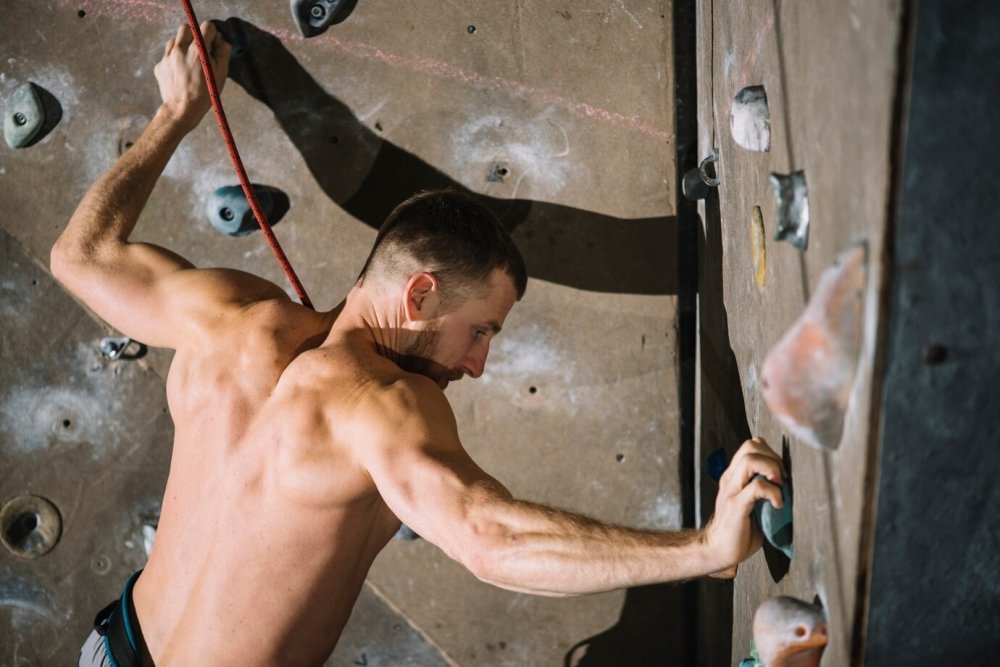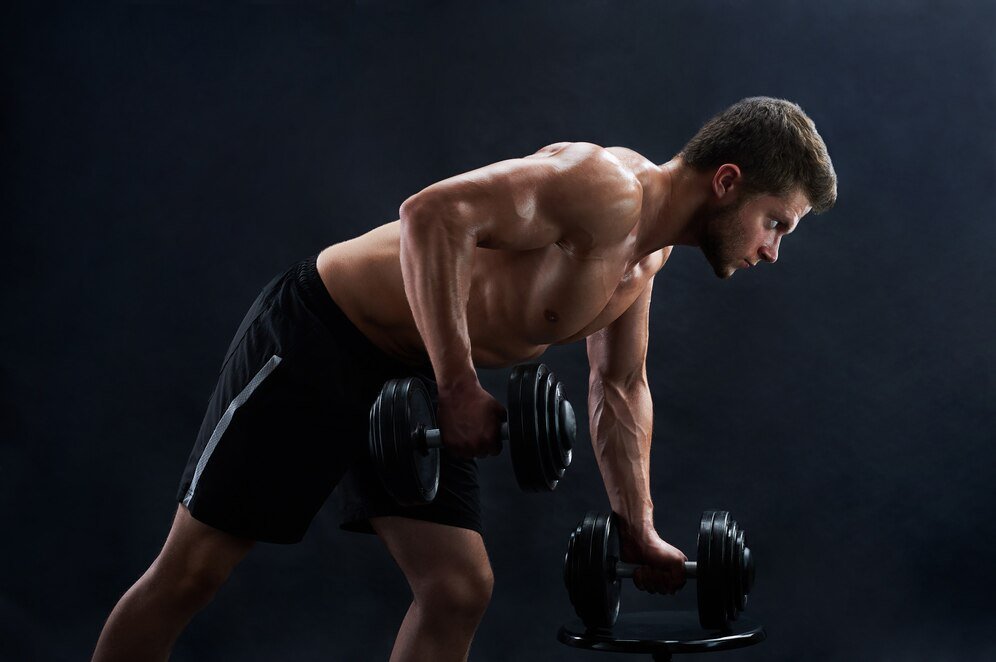Ready to take your skills to new heights?
It really doesn’t matter if you're a budding gymnast or someone looking to build strength and agility, having powerful arms is key to conquering the world of flips, tumbles, and gravity-defying stunts.
We've got just the thing for you – a straightforward arm workout for gymnastics that will leave you feeling stronger and more confident in no time.
So, are you ready to sculpt those biceps, triceps, and shoulders to become a gymnastics powerhouse?
Arm Workouts For Gymnasts (Beginners & Pros)
Listed below are the best at-home arm exercises and workouts for gymnasts:
1. Gripzilla Tornado

Gripzilla Tornado offers gymnasts a targeted and versatile tool for enhancing arm strength.
The controlled execution of the Tornado exercise engages the forearm muscles, wrists, and grip strength, which are crucial components for gymnasts performing intricate maneuvers on various apparatus.
By holding the Tornado firmly and curling it upward, gymnasts activate the muscles responsible for controlling the arms and maintaining stability during dynamic movements.
Execution:
- Hold Gripzilla Tornado firmly, position roller at the bottom.
- Set adjustable resistance for your strength level. Stand upright, extend arms, and curl Tornado upward.
- Flex wrists, contract forearm muscles, avoid jerky movements.
- Hold briefly at chest level, then reverse the motion slowly.
- Experiment with hand positions and personalize movements.
- Gradually increase resistance for steady strength development.
2. Gripzilla Dynamo

Gripzilla Dynamo proves to be a dynamic and adaptable tool that can significantly contribute to a gymnast's arm strength development.
The dual-directional rotations engage forearm muscles comprehensively, promoting balanced strength throughout the arms.
Gymnasts can get creative with personalized movements, targeting specific areas of the arms and promoting functional strength applicable to their sport.
Execution:
- Adjust resistance on Gripzilla Dynamo by rotating knobs.
- Customize resistance for individual strength and fitness goals.
- Choose hand position (horizontal, vertical, 45-degree angle).
- Engage in dual-directional rotations for forearm muscle activation.
- Get creative with personalized movements targeting specific areas.
- Gradually progress by starting with comfortable resistance and increasing intensity.
3. Ring Dips

Ring dips are an exceptional arm exercise for gymnasts aiming to develop formidable arm strength. This movement targets the triceps, shoulders, and chest, promoting explosive pushing power.
The instability of the gymnastics rings demands increased stabilization from the muscles, enhancing overall upper body control.
Ring dips also engage the core, reinforcing the importance of a stable midsection in gymnastic movements.
As gymnasts progress in mastering this exercise, they cultivate the strength necessary for various dynamic maneuvers on the rings.
Execution:
- Start by grabbing the rings with a firm grip, palms facing inward.
- Jump or step into the rings, supporting your body weight on straight arms.
- Lower yourself by bending your elbows until your shoulders are below your elbows.
- Push back up to the starting position, fully extending your arms.
- Keep your body straight throughout the movement, engaging your core and chest.
4. Hanging Leg Raises

Hanging leg raises are an invaluable arm workout for gymnasts seeking to fortify their arm strength and core stability.
This exercise primarily targets the abdominal muscles but also engages the grip strength, shoulders, and forearms as the gymnast hangs from a bar. The controlled lifting and lowering of the legs demand significant upper body strength, contributing to enhanced overall body control.
As gymnasts advance, the strength gained from hanging leg raises translates into improved performance in movements that require a strong and stable upper body foundation.
Execution:
- Start with your legs hanging straight down.
- Keep your core tight and raise your legs upward, aiming to lift them as high as possible.
- Control the descent as you lower your legs back down.
- Avoid using momentum; focus on using your abdominal muscles.
5. Muscle-Ups

Muscle-ups are a pinnacle exercise for gymnasts, demanding a combination of upper body strength and coordination.
This dynamic movement engages the arms, shoulders, chest, and back muscles, requiring an explosive pull-up followed by a forceful dip.
Mastering muscle-ups not only enhances arm strength but also develops the capacity for seamless transitions between different elements, a critical skill in gymnastics routines.
Execution:
- Begin with a standard overhand grip pull-up.
- As you reach the top of the pull-up, transition your body forward, bringing your chest towards the bar or rings.
- As your chest moves forward, explosively push down and pull your body up, using the momentum to transition into a dip position.
- Complete the movement by straightening your arms at the top.
6. Parallel Bar Dips

Parallel bar dips are an effective means for gymnasts to target the triceps, shoulders, and chest, contributing to robust arm strength.
This exercise provides a stable platform for controlled dips, isolating the upper body muscles involved in pushing movements. Parallel bar dips also emphasize shoulder stability and alignment, crucial for gymnasts executing skills that require precise arm positioning.
As gymnasts progress through different dip variations, they enhance their ability to generate power through the arms, supporting their performance in a wide range of gymnastic exercises.
Execution:
- Start by gripping the bars with your palms facing inward and arms fully extended.
- Lower your body by bending your elbows until your shoulders are below your elbows.
- Push back up to the starting position, fully extending your arms.
- Keep your body upright and avoid leaning too far forward.
7. Front Lever Progressions

Front lever progressions serve as a fundamental component of arm strength development for gymnasts.
These exercises engage the arms, shoulders, and upper back while challenging the core and overall body tension.
As gymnasts work towards achieving a horizontal position in the front lever, they build substantial strength in the biceps, forearms, and shoulders.
This exercise series promotes a solid foundation for controlling and manipulating the body in various planes, a critical skill in gymnastics routines that demand intricate and controlled movements.
Execution (Tuck Front Lever):
- Begin in a hanging position with palms facing forward.
- Tuck your knees towards your chest while simultaneously pulling your shoulder blades down and back.
- Aim to achieve a horizontal position with your body parallel to the ground.
- Maintain tension in your core and engage your lats throughout the movement.
Over To You
Here’s a simple yet effective arm workout that's perfect for anyone looking to enhance their gymnastics skills.
Consistency is key, so make sure to incorporate these exercises into your routine regularly.



